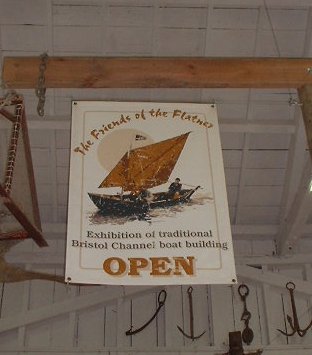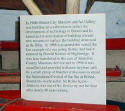Dories are North American thing,
or so the usual story goes: they are derived from the
bateau and have just a few ancient relatives around the
Mediterranean. It's less well known that they have been
exported to one or two places outside the US and Canada
as a useful boat type, including northern France and Denmark.
And it's probably even less well known that the Banks
dory has a close relative in the Bristol Channel, a large
estuary on the south-western side of England famous for
its treacherous currents.
 Locally,
these boats have two names: in Watchet on the Somerset
bank of the Bristol Channel, it's the Watchet Flatner,
while nearer the River Parrett it becomes the Parret Flattie.
There's a 16ft river boat version, but the one that interests
me most is a strange and lovely heavily built 19ft slab-sided
dory with a heavy bottom built flat on the inside and
cut to be convex on the outside - the bottoms were cut
round to prevent them from becoming stuck in mud, and
many of the boats' key features appear to derive from
Norse craft, including the traditional bailer, thole pins,
and the narrow-bladed oars with a square loom. Locally,
these boats have two names: in Watchet on the Somerset
bank of the Bristol Channel, it's the Watchet Flatner,
while nearer the River Parrett it becomes the Parret Flattie.
There's a 16ft river boat version, but the one that interests
me most is a strange and lovely heavily built 19ft slab-sided
dory with a heavy bottom built flat on the inside and
cut to be convex on the outside - the bottoms were cut
round to prevent them from becoming stuck in mud, and
many of the boats' key features appear to derive from
Norse craft, including the traditional bailer, thole pins,
and the narrow-bladed oars with a square loom.
These little sailers were tough little boats that lived
a hard life on the difficult waters - if a crew wished
to beach between tides, it's said that it was quite normal
to beach the boat at low tide and leave it there full
of stones to be retrieved eleven hours later after a meal
and a night's sleep - and not surprisingly although a
number of the river boats still exist, only one of the
sea boats has survived.
These photographs were taken this summer at the Flatner's
home museum in the little coastal town of Watchet. I think
this is a great little museum and well worth our support
- so please, if you like these pictures, do pay a visit
when you're in the West country of England, and put a
few pounds in the collection box! (click
pictures to enlarge)

Kimber's Flatner |

story |

bow quarter |

lines |

forward |

looms |

aft and blades |
PS I promised you a post-script, and
here it is: two pictures of a device called a mud horse
used for working fishing nets out on the mud of the
Bristol Channel. Now here's a project for someone who
is completely without fear and likes working in plywood!
|

